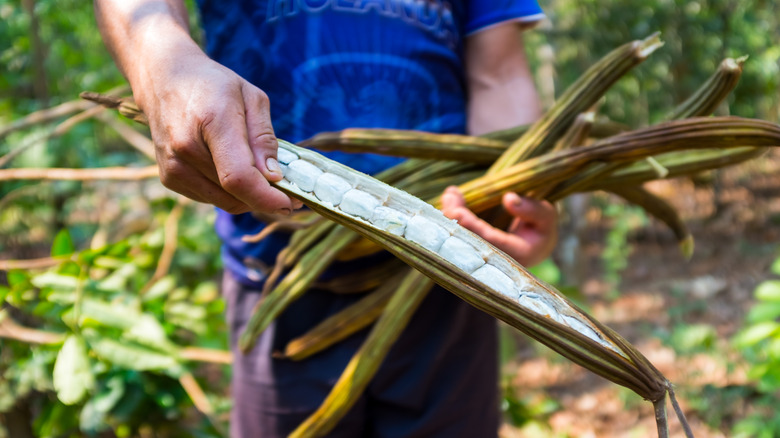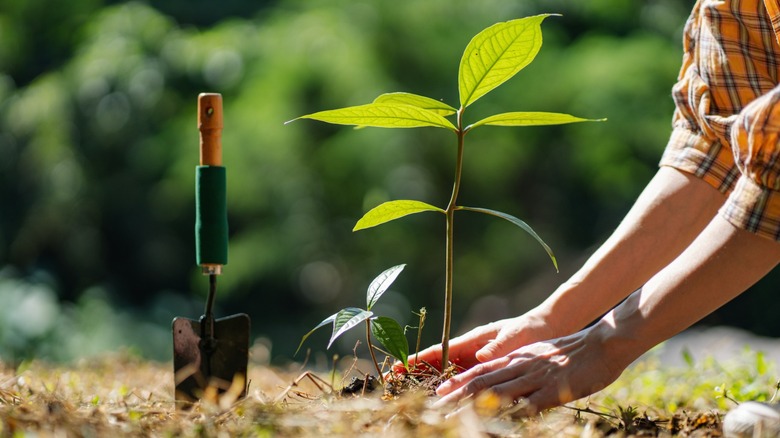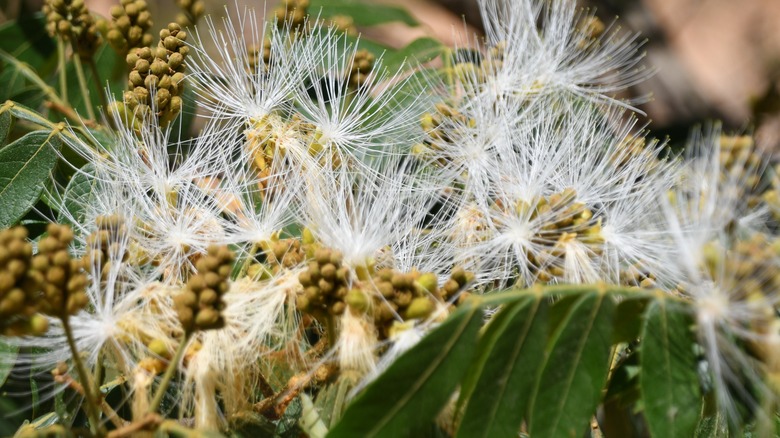Grow Sweet Treats From Mother Nature With An Ice Cream Bean Fruit Tree
Ever fantasize about growing desserts on trees? Well, you can get pretty close with the ice cream bean tree (Inga edulis), a tropical tree bearing fruit that tastes like vanilla ice cream. Native to South and Central America, this captivating tree is part of the legume family, and can grow up to 30 meters/98 feet tall in the wild with ideal conditions. Once flowering, it produces large, flat, fibrous green pods that hang from the tree in spiral or straight formations. Each pod measures six to 12 inches and contains dark purple seeds nestled in its translucent pulp, which resembles fluffy cotton candy.
The pulp is commonly consumed fresh straight from the tree, peeled from the pod by hand, then sucked or slurped from its encasing. Rich in fiber and carbohydrates, it's tasty by itself, and also works well as a flavoring for sweet dishes. In its native regions, the incredible tree offers growers many uses, including as a shade tree on coffee plantations, food source, and an ingredient for the Colombian alcohol cachiri. While it's sugary pulp is the main draw, you can also eat the seeds after roasting them, though the pod itself is inedible.
Growing your own food, whether a container of strawberries or via cultivating a fruit orchard in your backyard, offers a deep sense of satisfaction, plus a delicious bounty; this tree is no exception. No, you aren't going to fulfill your Willy Wonka childhood fantasies growing literal candy bars or gum drops outside, but you can enjoy a naturally sweet treat straight from your garden, which is almost as good. Here's how to grow your own ice cream bean tree.
Growing your ice cream bean tree
The ice cream bean fruit tree may be grown outside in USDA hardiness zones 10a to 11, but can also be cultivated in a patio container in zones 4a to 11. It needs sunlight for six to eight hours of the day. An important aspect when growing this tree in a container is to give it plenty of space and the well-drained sandy or loamy soil that will make your fruit tree flourish, with a pH between 5 and 6.5. In addition to producing naturally sweet dessert-like fruit, this tree offers valuable benefits to your other plants, especially if you determine that your soil needs nitrogen. As a legume, the ice cream bean tree replenishes the surrounding soil with nitrogen using its root nodules, which helps naturally improve its own soil. It therefore won't need fertilization, only potassium if it's losing leaves.
For saplings, Trees.com advises that you dig a hole as deep as the root ball and two times as wide. With your tree upright, fill around the topsoil, pushing it down to settle without air gaps. After watering, add a layer of mulch around the roots. Despite being a tropical fruit tree, Inga edulis is relatively drought-tolerant, though you should still water it weekly. When still a sapling, it's best to water it every couple days, switching to weekly once there's new growth. You can monitor the soil's moisture by checking with your finger, pushing it two inches down into the soil. A good practice is to let the soil dry between waterings. Once it's established, the tree can tolerate environmental extremes, including flooding.
How to care for and harvest fruits from your ice cream bean tree
Inga edulis produces beans following its clustered groups of nocturnal bristly white flowers, which arrive within three to five years of planting. While a self-pollinator, the tree also attracts bees and other pollinators for cross-pollination, thanks to the flowers' interesting design. Fruit should appear after the flowering, provided you have kept it healthy. It's time to harvest when the pods are firm and turn a shade of brown-yellow. Pull the pods by hand or remove them with a pair of shears, being careful not to cut the pods' flesh. After it produces its first fruits, you can harvest pods from the ice cream bean tree twice yearly. Once harvested, the fruity pulp can keep for a week if kept within the pod.
Unlike many other fruit trees, the ice cream bean tree doesn't require regular pruning. Instead, you may prune as needed, removing any dead or damaged limbs for better airflow. Pest and disease worries for it are minimal, though the South American fruit fly or pink hibiscus mealybugs may appear; these can be treated by removing any open fruit, as well as rubbing the leaves with neem oil or alcohol. You can also grow the ice cream bean tree from seed. They germinate quickly, but the seeds are only viable for a short time, so you must act fast once you receive them. Pre-soak them for 24 to 48 hours before planting them for best results.


